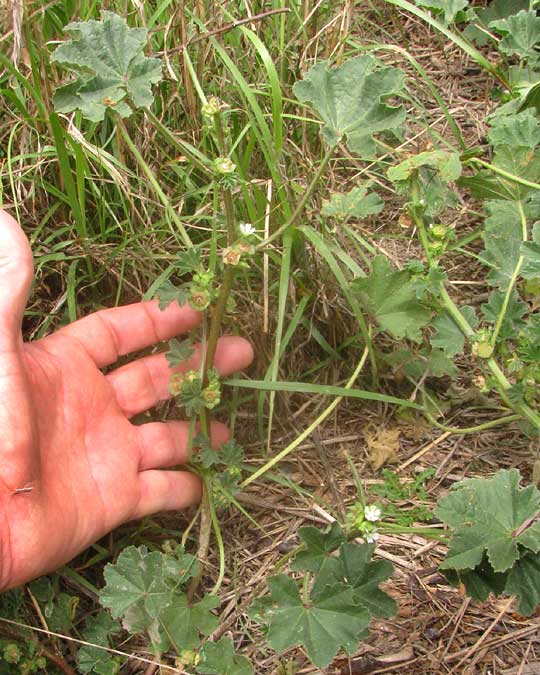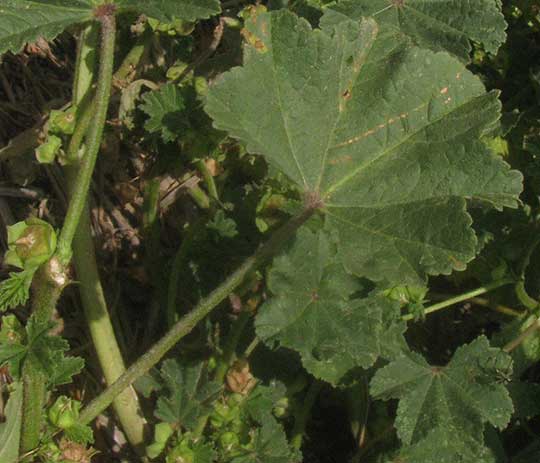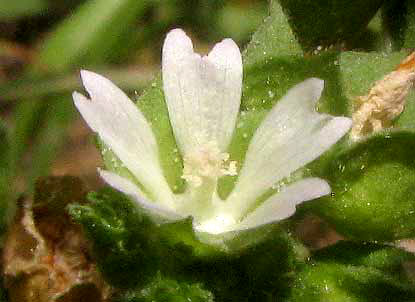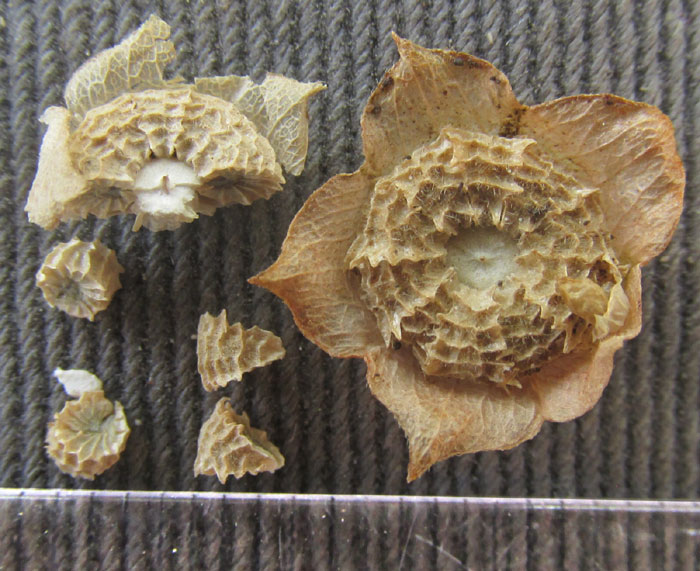Excerpts from Jim Conrad's
Naturalist Newsletter
from the April 13, 2014 Newsletter issued from the Frio Canyon Nature Education Center in the valley of the Dry Frio River in northern Uvalde County, southwestern Texas, on the southern border of the Edwards Plateau; elevation ~1750m (~5750 ft); N29.62°, W99.86°; USA
CHEESEWEED
Especially in Mexico we've seen many species belonging to what books often call the Mallow Family, the Malvaceae, but which I tend to call the Hibiscus Family, since most North Americans don't know what a mallow is. The mallow genus, Malva, is native to Eurasia and Africa, which explains why most Americans don't know it.
Still, one of the most rampant, vigorous weeds in certain disturbed spots around Uvalde is a mallow -- an invasive species from the Old World -- the one shown below:

The leaves on that plant look a bit like those of hollyhocks and the Rose of Sharon, which makes sense, because those species also are member of the big Malvaceae, along with such famous plants as cotton and of course hibiscuses. A better look at a leaf appears below:

Happily, flowers in the Hibiscus Family are easy to recognize. You can see our Uvalde mallow's blossom showing some of the main features below:

Note that in the flower's center the numerous stamens join at the bases of their filaments to form a cylinder, which surrounds the slender style connecting the hidden ovary with its stigmas nestled among the stamens' bunch of anthers. When you see such a "staminal column," think "Hibiscus Family."
Fruits of species in the Hibiscus Family come in a variety of forms. One common type is produced by our mallow, shown below:

Technically, this kind of fruit is known as a "schizocarp," a schizocarp being a dry fruit that at maturity splits into sections known as "mericarps." Mericarps can contain one to several seeds. The intact schizocarps of our Uvalde weed-mallow reminds enough people of a sliced wheel of cheese that probably our plant is best known by the names of Cheeseweed and Cheeseweed Mallow. It's MALVA PARVIFLORA, the "parvi" in parviflora meaning "small," pointing to the fact that Cheeseweed's corollas are small compared to those of closely related mallows.
Cheeseweed's leaves don't have much of a flavor but they can be mixed with other greens and cooked in a pot. The ancient Greeks are said to have made a green sauce with Cheeseweed leaves, and used them as a substitute for grape leaves when making the stuffed vegetable dishes called dolmas.
Native to Eurasia and northern Africa, Cheeseweed now invades weedy areas throughout the warmer parts of the world. In the US it's found mostly in the southwestern states, though it turns up here and there elseswhere.
entry dated April 4, 2023, issued from near Tequisquiapan; elevation about 1,900m, (6200 ft), ~N20.57°, ~W99.89°; Querétaro state, MÉXICO
(~N20.55°, ~W99.89°)
CHEESEWEED IN MEXICO

We have Cheesweed here in the semiarid uplands of central Mexico, and this time when we met, I spent more time admiring the fruits. The picture above shows a local schizocarp subtended by its papery calyx, and to its left, there's half a schizocarp with four mericarps below the half. From above, the mericarps look like flat slices of a schizocarp pie, as with the two nearest the whole fruit on the right. However, at the picture's edge, two mericarps provide side views. There it's seen that each mericarp is like a very thick C -- not closed on one side. The ruleer at the bottom is measured in millimeters.
These mature schizocarps are too hard to simply squeeze with the fingers to cause the mericarps to come loose. A thumbnail can do it, though, and a really hard grinding with a nail can cause the mericarps' honeycomb-like coverings to break, releasing the single seed inside them. Presumably, on the ground, once the schizocarps are moistened and bacteria act on them, they'll disintegrate.
Endless variations on the schizocarp/mericarp theme can be observed, each species producing its own concept. Sometimes the mericarps are more numerous, bladder-like and split open to release their seeds, as seen on the bottom of our Narrowleaf Globemallow page. Sometimes the mericarps are less numerous and bear toothlike projections, as seen at the bottom of our Big Yellow Velvetleaf page. Sometimes the mericarps separate and fall out one-by one, leaving the schizocarp looking like a pie with missing slices.
Being a foreigner in Mexico, Cheeseweed doesn't have much of a history as a traditional food. However, the Spanish introduced Cheeseweed into the culture so early that, according to the undated "Guía Ilustrada de Plantas Medicinales en el Valle de México" by Rafael Enrique Fonseca Chávez and others, since the 1500s the plant has gained fame among Mexicans as a curative for a long list of ailments. It's been used for toothaches, intestinal worms, bronchitis, angina, cramped muscles, urinary problems, and more.
In a 2021 study by Ans Munir and others entitled "Malva parviflora Leaves Mucilage: An Eco-Friendly and Sustainable Biopolymer with Antioxidant Properties," the plant's potential for medicinal purposes is supported. They say that Cheeseweed leaves have mucilagenous (~slime) cells and that the mucilage, among other things, not only can be nutritive, but also shows noticeable antioxidant activity, prevents oxidative damage to DNA, and can protect against too much sunlight.
By the way, note that our Mexican observation is made at about the same time of year the above Texas entry was issued. We're much farther south here and considerably higher in elevation, but somehow the seasonal life cycles of the two populations are about the same. I've noticed this with numerous species.